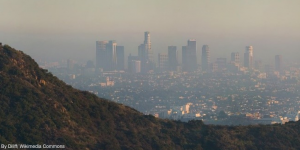
A call for urgent action: First-ever WHO conference on a killer that cuts short millions of lives a year
Sarah Vogel, Ph.D., is Vice-President for Health.
To breathe—from our very first breath to our last—is to be alive. But for billions of people around the world, that simple, necessary act is at risk due to pollution. For the hundreds of millions of children and adults with asthma struggling to breathe, the immediate and acute experience of breathing polluted air cannot be mistaken. And scientific research tells us that air pollution is also cutting short the lives of an estimated 7 million people a year due to heart attacks, stroke and respiratory diseases. For some context, that is more than the total lives lost to HIV/AIDS, malaria and tuberculosis combined.
Everyone on this earth has a right to breathe healthy air. But today, too many countries around the world are facing serious air pollution crises. That’s why people from all around the world—government officials, civil society organizations, artists, and academics—have gathered this week in Geneva, Switzerland for the first World Health Organization Global Conference on Air Pollution and Health. And it’s why we’re here: to call for urgent and immediate action to address global air pollution.
Innovative solutions to air pollution
In a world where the vast majority of people live in cities and where the air is unhealthy, it is imperative that we understand air pollution within large urban areas. Air pollution information from regional monitors have been essential in many parts of the world, including the US, to assess and manage major sources of pollution, but they do not provide insights into city-level distribution. To fill this critical information gap, Environmental Defense Fund (EDF) is working with a diverse community of experts, advocates, government officials, sensor developers, and private industry to develop scientifically robust, cost-effective approaches to mapping air pollution at the hyperlocal level using lower cost, mobile and stationary monitors, and to use these insights to assess impacts and advocate for clean air solutions.
In Oakland, California, EDF partnered with Google Earth Outreach, Aclima and University of Texas to produce the first-ever hyperlocal air pollution maps. We’ve expanded our hyperlocal mapping efforts to Houston, Texas; the broader Bay Area, California and – most recently –to London, England.
Air pollution insights that drive solutions
Turning local insights into on-the-ground solutions to clean air means translating new data into action. And that doesn’t happen overnight. City officials—planners, regulators, public health experts—are rolling up their sleeves alongside community groups and academics to develop and implement clean air policies.
In Oakland, we’re working with partners to use hyperlocal air pollution data to inform community air pollution reduction plans. These plans are part of California’s new Community Air Protection Program as part of the implementation of the state’s new law, AB617, which passed last year.
And in Houston, we worked with the city to pilot air pollution sensors on fleet vehicles, and are developing detailed air pollution data to identify vulnerable communities and prioritize local sources for emission reductions. Through the One Breath Partnership—a collaboration among advocates and local universities that EDF coordinates—we’re urging Houston to become a world leader in clean air.
For communities across the world to effectively address air pollution, they will need powerful insights into air pollution—its distribution, sources, and impacts on people and their pocketbooks—to develop sound solutions that reduce pollution and advance prosperity.
Make no mistake, air pollution is a complex problem; but today there are new tools and technologies to support the needed insights; committed leaders in government, civil society, academia, health providers and the private sector; and a powerful groundswell of public demand for action. Together, these forces can lead the way towards a healthier future.












